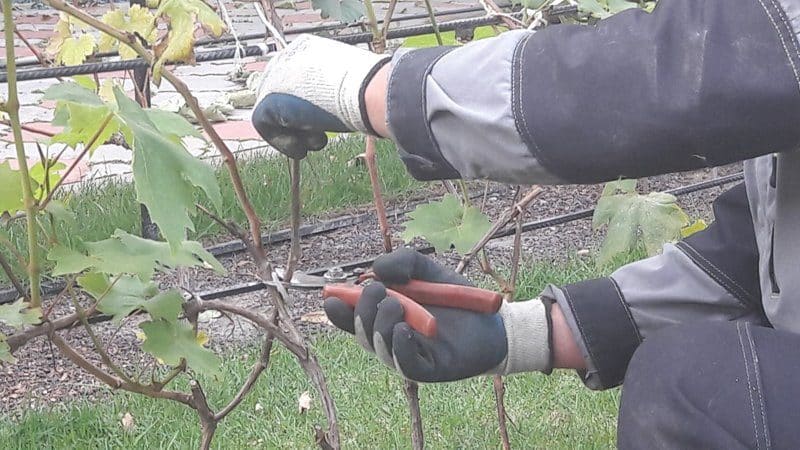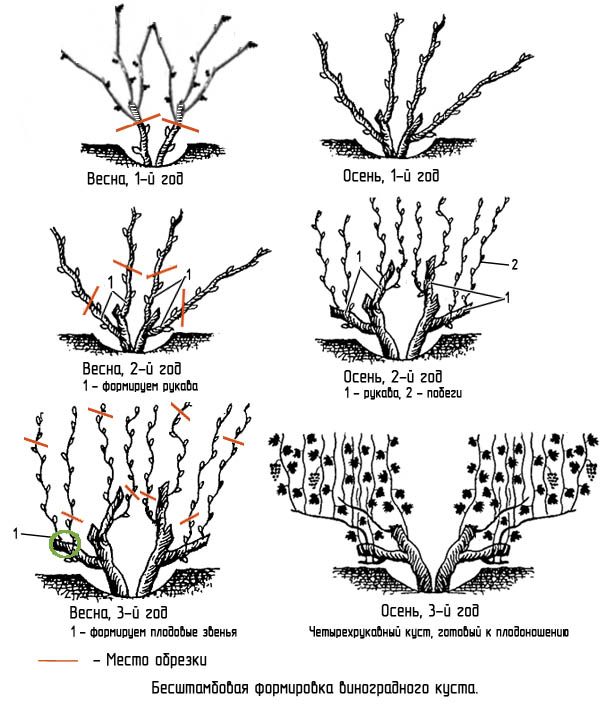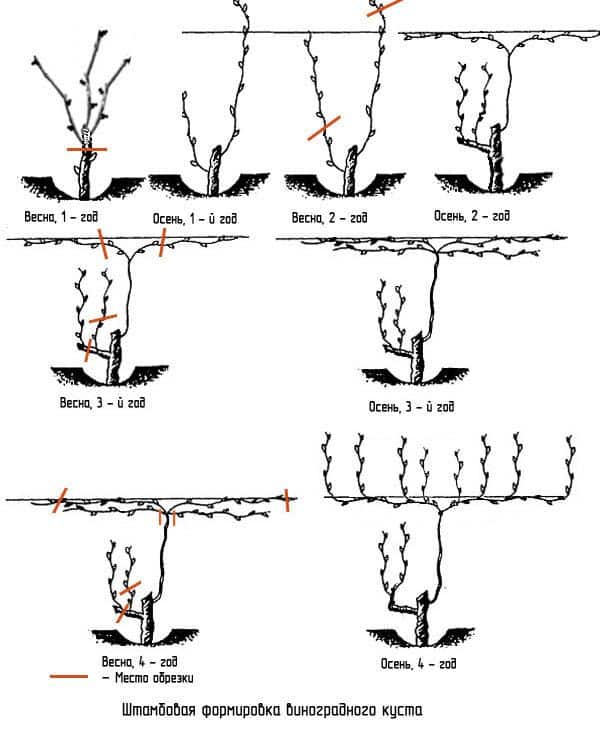Why do you need to prune grapes in the fall and how to do it correctly?
Formation grapes - not an easy task for beginners. But proper pruning is the key to obtaining a stable harvest of tasty berries. We will tell you in detail how to prune grapes in the fall.
The meaning of autumn pruning
The grape vine has an interesting feature - polarity. It manifests itself in the fact that shoots from the upper eyes of last year’s vine develop faster and better. In the middle and lower parts of the vine, the eyes develop weaker or do not produce shoots at all.
Every year many new buds and shoots grow. Provide them with adequate nutrition plant can not. Therefore, grape bushes are formed, leaving as many shoots as the root system can “feed”.
The point of autumn pruning is to regulate growth and fruiting during the next season. A correctly carried out procedure contributes to high yields and uniform plant growth.
With the wrong approach, the balance is disturbed, which leads to the strengthening of one of the processes at the expense of weakening the other - growth/yield.

If the grapes are not trimmed
The free-growing vine constantly lengthens, the branches grow, and the size of the bush increases significantly. But the root system is not able to provide all the formed shoots and bunches with the necessary nutrition.
This leads to crushing of the berries and a deterioration in their taste already in the first year of free growth.The next year, the size and number of berries in the clusters will further decrease, and after a few years the bush takes on the appearance of wild grapes.
Types of pruning
Depending on the purpose, there are different types of pruning of grape bushes.
Formative
This type of pruning is aimed at forming a strong skeleton of the bush in the first 3-4 years of growth. This can be standard-free (with two or more sleeves located close to the ground) or standard-formed (bearing sleeves rise above the ground).
Regulatory
In the future, regulatory pruning is carried out annually. It allows you to maintain a balance between the development of the bush and the fruiting process. With regulating pruning, excess young shoots are removed.
Rejuvenating
This type is used when the plant gets old and stops growing. The grape bush needs rejuvenation after 5-8 years of growth. In this case, the old sleeves are cut down and new ones are formed from the shoots located at the base of the bush.
Deadlines
Pruning of grapes in the fall begins 1-2 weeks after the leaves fall. Complete work before frost arrives.
In the southern regions, vines are pruned from September to November. In the middle zone, this work is completed by mid-October. And in the Urals and Siberia - until the end of September.
Timely pruning allows the plant to recover before the onset of cold weather and successfully winter.
Technology
Mistakes made during the formation of a bush can reduce the yield or leave no harvest at all, and in the worst case, lead to the death of the plant. How to carry out this procedure correctly?

Required materials and tools
To carry out the procedure, you will need a sharp knife or garden shears (secateurs). A sharp tool makes a neat cut that quickly overgrows.
Scheme
There are two main types of grape formation – standardless and standard formation.
Formless forming
The shape of the bush is set, gradually shaping it over the first four years. In the first year, young shoots are pinched and weak and underdeveloped ones are removed. In autumn, 1-2, sometimes 4 shoots are left on the plant.
In the second year, 2-3 well-developed shoots are left, from which sleeves are formed. Each of them is cut into 2-4 buds. From these buds, two vines are left as the bush grows. In the fall, each of these vines is shortened to the length of the mature wood.
In the third year, two buds are left on the vine, located closer to the base. The shoots that grow from them will form the sleeves of the bush. They are attached to the support horizontally and two eyes are left on each.
The shoots emerging from the eyes are attached vertically. They form fruit links.
Need to know! The fruiting link is the two lower vines on the sleeve.
In the third year, one fruiting link is left on the plant. In the fruiting section, the lower shoot facing the outside of the bush is cut into 2-4 buds - this is a replacement shoot. The shoot located above is pruned into 6-8 buds - this is the arrow of fruiting.
In the autumn of the third year, the bush consists of two fruiting links (one on each sleeve). Two vines are left on the replacement knot - the future fruit link. The fruiting shoot is removed, and a new fruiting link is formed on the replacement shoot. This formation principle is repeated every year.
In the fourth year, the plant is considered mature. In the future, pruning is carried out every autumn according to the described principle.

Standard formation
This type of plant formation is used in regions with mild climates.
In the first autumn, two shoots are left on the seedling.In the spring of the second year, the shoots are pruned: the main one - into three buds, the second - into two. A more powerful shoot is formed as a standard, and the second one is kept as a spare.
The standard is mounted vertically. In autumn, two shoots are left on the trunk and spread in different directions, securing them horizontally. The tips of these shoots are pinched. All the other eyes on the standard vine are blinding. On the reserve shoot, the vines are cut to 3-4 buds.
In the 3rd year in the spring, two long shoots, fixed horizontally, are cut into two buds. These will be the sleeves of the bush. In the summer, four shoots will grow on them - two on each shoulder.
The eyes on the main trunk are blinding. On the reserve side, one vine is left, located closer to the base of the bush with two buds, the second is removed. By autumn, two branches will develop on this shoot, which are cut as follows: the outer lower one - with two eyes (reserve), and the second - with six eyes (reserve fruit arrow).
In the fourth year in the spring, pruning is done on the sleeves of the main trunk for fruiting. The shoot closer to the base of the trunk is cut into a spare branch, leaving two buds, and closer to the top - to the fruiting arrow, leaving 5-6 or more fruit buds. There may be several such links on a sleeve. The harvest is formed on the fruiting arrow.
In all subsequent years, pruning is carried out according to the principle of the fruit link, consisting of a replacement knot and a fruiting arrow. Excess fruit links from the previous year are removed.

Trimming instructions
The blades of all tools used must be well sharpened and disinfected with an alcohol-containing product.
The most convenient tool for cutting young shoots is a pruner. A garden saw is used to remove old, thick vines.
The cut is made carefully at a right angle, leaving an even and smooth stump. This will speed up healing, since the wound area will be smaller than with a sloped cut.
Features depending on region

The choice of the type of formation of a grape bush is influenced by the climatic conditions of the growing region. In the south, where the climate is mild, they use a non-covered method of growing grapes. Here, forming on a trunk (or fan method) is used, which allows you to get the maximum yield.
When grown in the Moscow region, the Urals and Siberia without shelter for the winter, the vine freezes. Therefore, grapes are formed here so that they can be wrapped in the cold season. Here they use a cordon (short-sleeved) formation scheme, in which the head of the bush is located close to the ground.
Care after pruning
After completing the autumn pruning procedure, the cut sites are treated to protect against infections. For treatment, use “RanNet” - a special paste with an antiseptic that disinfects the wound and promotes rapid healing - or melted garden pitch.
Shelter for the winter
Pruned and cured vines are covered for the winter. In regions with harsh winters, this is a must. preservation of grapes.
They begin to cover from the beginning of October. The vines tied in bunches are laid on the ground and sprinkled with a layer of 5-10 cm of earth. You can first wrap the bush with covering material or burlap, and then cover it with earth.
Another method of insulation is to cover the vines with wooden boxes, which are covered with film on top.
During the winter, it is also necessary to monitor the depth of the snow cover. The snow layer should be at least 40-50 cm thick.
Conclusion
Without the formation of grapevines, it is impossible to obtain a harvest of large and tasty berries.Growing freely, the bush occupies an ever larger area. The berries become small, and access to light and air circulation inside the bush become difficult. This leads to the development of diseases and the spread of pests.
Therefore, autumn pruning is an obligatory stage of vineyard care. The autumn pruning scheme is chosen based on the growing conditions.